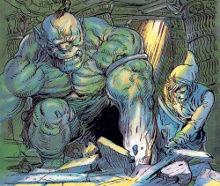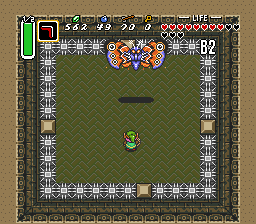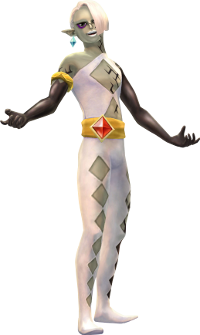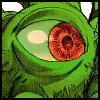Zelda Bosses: Downsizing the Enemy
Posted on December 07 2012 by Axle D. Wilder
 It’s interesting to talk about the size of the bosses in the Zelda series, and I wrote about this before in another article, where I talked how the bosses in Zelda had stagnated in terms of concept and design. All the bosses at the time seemed to be titanically huge, follow a tired, predictable formula, and were ironically extremely easy to beat despite their intimidating size. Skyward Sword seems to have begun to reverse that trend a bit, but I’ll get into that later. The main thing is, after Skyward Sword, I think this topic should be revisited in more detail.
It’s interesting to talk about the size of the bosses in the Zelda series, and I wrote about this before in another article, where I talked how the bosses in Zelda had stagnated in terms of concept and design. All the bosses at the time seemed to be titanically huge, follow a tired, predictable formula, and were ironically extremely easy to beat despite their intimidating size. Skyward Sword seems to have begun to reverse that trend a bit, but I’ll get into that later. The main thing is, after Skyward Sword, I think this topic should be revisited in more detail.
I extend this to two different things. The first is human or humanoid bosses, like from the major species you interact with throughout the game. These would be characters you would clash with for one reason or another as part of the plot (or at least have a reason they’re fought) serving as full and detailed battles.
But the subject of my article also extends somewhat to smaller bosses that aren’t humanoid at all. These simply have similar size, power, or traits, to humanoid creatures, separating them from the titanic colossi we see in many modern Zelda games.
I should acknowledge that we have had bosses like these in the past. Particularly in older games, but there are even examples in The Wind Waker and Twilight Princess, though sadly this is typically limited to minibosses. My point, however, is that we could really use more of these smaller, humbler bosses. And not just occasionally — sprinkled here and there throughout the series — but as a recurring aspect of future games that’s balanced with the already common giants. I’ll tell you why.
To start, reintroducing another size category encourages variety, as I discussed in my previous article on this topic. Obviously, it’s different to fight a smaller opponent than it is a large one, and it increases variety that way, but there are also simply different options available for boss design with a smaller size in mind.
For example, these fights would arguably be more strategic and interesting. They would be more complicated, or more importantly, more open, encouraging the use of many different methods for defeating the boss. This is in contrast to larger bosses, which are usually indomitable giants that can only be hurt by hitting a specific weak point, making use of their Achilles’ heel.
 Certainly, larger bosses can be designed without incapacitating weak points, and smaller ones designed with them. I’m simply saying that each size category naturally leans more one way than the other. Whether the boss is a humanoid character or a man-sized beast, the smaller it is, the more viable it is to attack it with different weapons, making it easier, simpler and more intuitive for the fights to have more options for the player.
Certainly, larger bosses can be designed without incapacitating weak points, and smaller ones designed with them. I’m simply saying that each size category naturally leans more one way than the other. Whether the boss is a humanoid character or a man-sized beast, the smaller it is, the more viable it is to attack it with different weapons, making it easier, simpler and more intuitive for the fights to have more options for the player.
This concept is displayed pretty well in A Link to the Past, where quite a few of the bosses (who are human-sized or only marginally larger), such as the Armos Knights or Mothula, can be hurt by any weapon that does damage to enemies. The game is a good example of balancing the different approaches, too, because many of the bosses are larger and have much more specific weak points. Generally speaking, A Link to the Past is the game that I think Zelda games should be mimicking more in terms of boss design.
Admittedly, it would be a lot more challenging to design good bosses with a smaller size. The larger bosses, though impressive, tend to have simpler rules, and downsizing the bosses necessitates more careful design to make sure the boss is not only fun (and interesting) to fight but also makes enough sense. In the worst-case scenario, the bosses would be buggy, have weird AI, or just be dull and all much the same: Nothing more than a string of uninspired sword-battles. So a lot of work would need to be put into these smaller bosses for them to be good, but really the same can be said of the larger ones; though the rules, or the formula, is simpler for making larger bosses, they still require effort to be good bosses, and we’ve seen plenty of both well-made ones and poorly-made ones throughout the series’ long roster of boss monsters.
Another foreseeable concern is the diminishing of the puzzle aspect of boss fights. I’ve always preferred action-oriented bosses where the puzzle aspect is either minimal or only one component of a more challenging battle. Some people, however, do prioritize the puzzles. I don’t think a breath of fresh air in the form of action bosses is a bad thing, but I don’t think that shrinking the bosses needs to diminish the puzzle aspect either. Again, while it might take more effort to implement puzzles in the smaller fights in a well-designed way, it’s still possible and shouldn’t be all that hard.
A final concern worth bringing up is the notion that smaller bosses wouldn’t be as impressive or epic.
It’s a fair point, as dungeons are major pieces of game content, and their bosses need to be able to serve as proper, epic transitions or finales for these areas. But, assuming that it’s true that smaller bosses can’t fulfill this role properly, that just means they’re fit for being used as overworld or storyline bosses; fought outside of dungeons, these foes would be optional or tied to the plot and would inject more variety into the game and help with transitions between sections of the overworld or story, just like King Bulblin in Twilight Princess did. We do need more of these.
 That said, I don’t think it’s at all true that smaller bosses have to be less epic. How many epic confrontations in movies and other media have been between two men? How about scary scenes in fantasy stories or even science fiction where the hero is beset by a deadly hunter beast not much larger than he is? Smaller size doesn’t need to equal smaller presentation or less impressive ideas; presentation is just another element that works alongside boss design and concept. They aren’t the same thing and can all work together in a myriad of different forms regardless of the concept.
That said, I don’t think it’s at all true that smaller bosses have to be less epic. How many epic confrontations in movies and other media have been between two men? How about scary scenes in fantasy stories or even science fiction where the hero is beset by a deadly hunter beast not much larger than he is? Smaller size doesn’t need to equal smaller presentation or less impressive ideas; presentation is just another element that works alongside boss design and concept. They aren’t the same thing and can all work together in a myriad of different forms regardless of the concept.
Shadow of the Colossus is a game that proved that puzzles and epic presentation can work fine with smaller bosses. Despite the game being about massive battles (much like those of Twilight Princess) it had a few small bosses that were some of the most intense and memorable fights of the game, and like all the rest were built around good puzzles. All they did differently was introduce a little variety by pitting you against a new size category.
There are bosses from within the Zelda series that nail this too, having not only epic presentation but managing to become fan favorites in the process. Dark Link from Ocarina of Time comes to mind. Skyward Sword, also, has managed to show through Ghirahim that smaller bosses can work well… even in terms of presentation. Love or hate him, I think it’s pretty hard to argue that Ghirahim didn’t have style and presentation, and each pre-battle confrontation with him carried a lot of weight.
Unfortunately, although Skyward Sword managed to do this, it did still largely follow the “big boss format”. While I think that all the fights in the game were pretty distinct (and it’s got my favorite boss lineup of any Zelda game), only a handful were smaller in size (most of which ended up being minibosses, once again) and only a handful had a lot of player freedom in defeating, still relying on the weak points for the majority. More importantly, while they were definitely different and I thought they were quite a lot of fun, all of the major boss battles against humanoid opponents, barring Demise, were against Ghirahim. And all of them, including Demise, were sword battles. It was a start in the right direction, but it didn’t have the variety I’m talking about (which proves that size alone isn’t the only factor here; balance also needs to be sought in boss design).
So let’s see some true variety. Take Skyward Sword’s example and build off it further. Let’s have humanoid bosses as well as beasts — ranging from human-sized to giants — all in the same game in a balanced roster, and have unique, distinct fights of all sorts.
 Before we end off, one final aspect worth touching on is the story implications. I’ve brought this up a few times already, and it should go without saying, but using characters of the intelligent species of the game’s world as bosses obviously means that many of the bosses will have more backstory, more personality, and a lot more impact on the story, or simply impact as characters on their own. It’s more conducive to building interesting boss personas.
Before we end off, one final aspect worth touching on is the story implications. I’ve brought this up a few times already, and it should go without saying, but using characters of the intelligent species of the game’s world as bosses obviously means that many of the bosses will have more backstory, more personality, and a lot more impact on the story, or simply impact as characters on their own. It’s more conducive to building interesting boss personas.
That applies to smaller boss monsters, too, because any creature in the story can be intelligent. Of course we can have intelligent giants too (and probably should), but generally speaking, the closer to human the creature is in any respect, be it shape or just size, the easier it will be to identify it as intelligent. Or at least that’s how I look at it. Obviously not all bosses need to be something more than mindless beasts, but it would be interesting and nice to see more that aren’t merely that.
Starting particularly with The Adventure of Link, Zelda used to have a lot of small bosses that weren’t much bigger than Link. I don’t know why it’s largely become about huge monsters lately. It’s nice to have them, certainly, and it goes a long way toward making the foes intimidating and reminds of the old fantasy trope of the hero fighting a powerful beast like a dragon or demon in order to save the princess and kingdom. But humanoid opponents bring to mind the duels, the evil knights, the soldiers, the warlords, and the wizards from the same kinds of stories.
At the very least, shrinking the bosses injects more variety into the boss lineup in terms of visuals, playstyles, challenges, and storyline opportunities. And in a series as wild as Zelda can be, more possibilities added to the pool can only be a good thing.
Like with many of its other aspects, Skyward Sword gave us a taste at what this direction for the series could offer us (in a better game). Let’s have more balance in terms of themes, and let’s enrich the game world and gameplay variety with this returning classification of boss. Let’s have more of the smaller bosses — humanoid or otherwise — without eliminating the more familiar titans. Make it happen, Nintendo!




